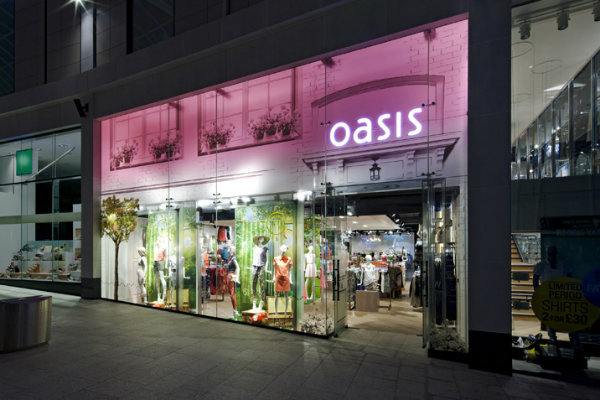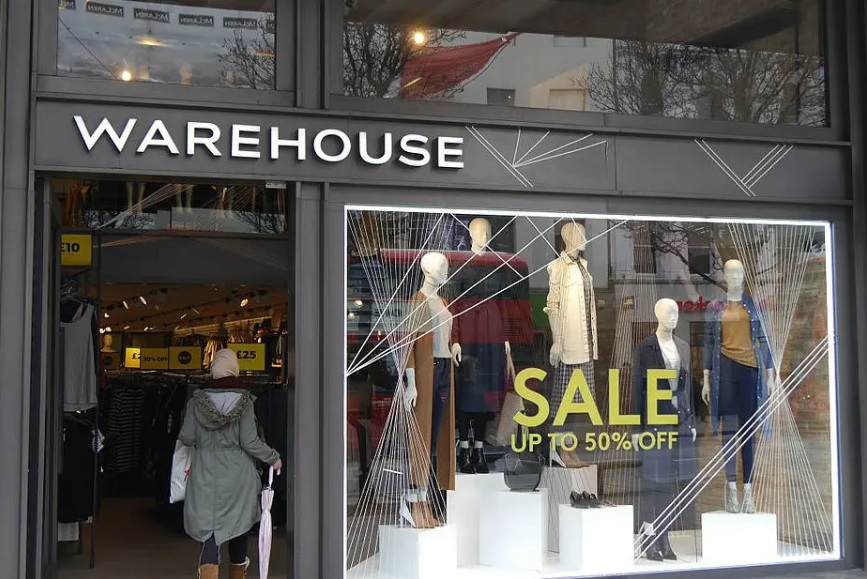

A BRIEF TIMELINE
1976: Warehouse was founded as the Warehouse Utility Clothing Company with the first store opening on London’s Duke Street.
1979: The retailer opened its second store on London’s Argyll Street, simultaneously announcing a change of name to Warehouse.
1985: Warehouse launched its first catalogue.
1991: Oasis was founded.
1995: Oasis was floated on the London Stock Exchange.
1998: Oasis purchased the Coast stores.
1999: Warehouse opened its first international store in Singapore.
2001: Oasis’ management team acquired Warehouse via Sierra Acquisitions Ltd, supported by PPM Ventures. Warehouse launched its website.
2003: Oasis, Warehouse and Coast acquired from PPM Ventures by a secondary management buyout, supported by Baugur Group and an investor group led by Kaupthing Bank.
That same year, fashion company Mosaic Fashions was established as the takeover vehicle when it acquired the Karen Millen and Whistles brands.

2009: Mosaic Fashions entered administration in March. Most of the businesses were immediately sold on to Aurora Fashions, a new company jointly owned by Icelandic bank Kaupthing – a major Mosaic creditor and Mosaic’s former management.
The deal saw Aurora take on the majority of Mosaic’s ongoing retail stores including Coast, Warehouse and Oasis. Principles was not included in this deal, and was subsequently purchased separately by Debenhams.
Meg Lustman was appointed to the newly-created role of managing director of Warehouse.
2010: Margaret Macdonald, previously chief executive of LK Bennett, became managing director of Coast, and Liz Evans was appointed managing director of Oasis.
2011: Karen Millen separated from Oasis, Warehouse and Coast as a new company owned by Kaupthing Bank – the same parent company as Aurora Group.
2013: Aurora announced further plans in March for a wider restructuring. As part of this, Coast was separated from the rest of the group, under the ownership of Kaupthing, and it was planned that Oasis and Warehouse would be merged under a new single parent company, Fresh Channel. The two brands were eventually merged as the Oasis & Warehouse Group.
Liz Evans was promoted to group chief executive.
2016: The administrator for Aurora Fashions, Kaupthing Bank, placed the retailers up for sale for ÂŁ100 million.
2017: In September, reports emerged that a UK-based Indian entrepreneur wanted by Interpol was working on a £60 million acquisition deal of Coast, Oasis and Warehouse. Emerisque Brands — the private equity form owned by Ajay Khaitan — had talks to buy the trio of retailers from Kaupthing. By October, a sale process for Aurora Group was abandoned.
2018: Liz Evans departed after eight years at Oasis & Warehouse to join rival FatFace. Chief operating officer Hash Ladha was promoted to chief executive.
That same year, Aurora placed Coast into administration, which was eventually acquired by Karen Millen. Both Aurora and Karen Millen are owned by Kaupthing, so Coast essentially remained in the family. While 600 jobs were saved, 300 were cut as the deal saw store closures, but kept the concessions, wholesale and online operations.

2019: Oasis and Warehouse acquired online menswear retailer The Idle Man for an undisclosed sum. In September, Oasis & Warehouse recorded a rise in sales and profits despite a “difficult” trading environment.
In the 53 weeks to March 2 2019, the Oasis & Warehouse saw EBITDA increase by 20 per cent to £11.5 million thanks to the opening of five new “local” stores in Dorchester, Haslemere, Ilkley, Ringwood and Tenterden.
Total sales at the group were up 6.5 per cent, compared with ÂŁ293.2 million in 2017/18, while online sales for the period were up 17 per cent, and now represent 30 per cent of the total.
Like-for-like sales were up 0.2 per cent, and total turnover was down two per cent, which was blamed on the planned closure of 11 unprofitable stores.
In April 2019, Aurora Fashions said House of Fraser’s administration had a £5 million impact on Oasis & Warehouse’s earnings, partly blaming it for a £10 million increase in pre-tax loss to £39.9 million.
The following August, although not part of Aurora Group but still owned by Kaupthing, Karen Millen and Coast were sold to Boohoo Group in a pre-pack administration. All Karen Millen and Coast stores and concessions eventually shut down, as Boohoo only acquired its IP and online business.
Meanwhile in October, Oasis began stocking third-party brands on its website for the first time as it launched brands from The Little Mistress Group.
2020: In March, Kaupthing drafted in advisers from Deloitte to explore a sale of the Oasis and Warehouse Group as the coronavirus crisis prompted the government to extend the lockdown.
On April 14, Oasis and Warehouse revealed it was preparing to slide into administration, putting 2300 jobs at risk. The following day, the group filed for administration, leading to 202 jobs being immediately made redundant while a further 1800 are at risk as they remain on furlough.
Oasis, Warehouse and The Idle Man would continue to trade online in the short-term while administrators assess options.
Oasis and Warehouse currently trades from 92 shops in the UK, plus 437 concessions located in third party retailers such as department stores.
THE REASONS
Oasis & Warehouse became one of the latest retailers to file for administration last week and many experts have told Retail Gazette that while the Covid-19 crisis is not primarily to blame for its demise, the pandemic was most likely the last straw for the already-struggling group.
Deloitte joint administrator Rob Harding said: “Covid-19 has had a devastating effect on the entire retail industry and not least the Oasis Warehouse group.”
Oasis & Warehouse chief executive Hash Ladha admitted that the “shocking and difficult news” of the administration could not have been predicted a month ago.
Arguably, the coronavirus pandemic pushed the company over the edge. According to files posted in Companies House, there was no major loss recorded in the run-up to its administration. In fact, Oasis & Warehouse posted a 20 per cent increase in its EBITDA to ÂŁ11.5 million in the 53 weeks to March 2, 2019.
“Cashflow is like oxygen and if you starve it of that, it doesn’t take long for it to go into administration,” Retail Reflections founder Andrew Busby told Retail Gazette.
“Cashflow is like oxygen, if you starve it of that, it won’t take long for it to go into administration”
However, insolvency partner at law firm Shakespeare Martineau, Sean Moran, argued that Oasis & Warehouse were both struggling, and a combination of reduced footfall on the high street, high rents in some unprofitable stores and difficulties in securing access to credit lines caused the firm to collapse.
Last year, Oasis & Warehouse was faced with difficulties as certain key credit insurers stopped offering credit to their suppliers, and a number of non-profitable stores were closed to protect profits.
While these are signs of a struggling retailer, there were many retailers in the same situation but with a different focus which allowed them to make changes to their operating models in a profitable way.
Coronavirus has struck at the worst time for many retailers whose cashflow may already have been running at close to negative. Arguably, Oasis & Warehouse was also affected due to the fact it did not harness technology as effectively as its rivals.
Rick Smith, managing director at business consultancy Forbes Burton, said Oasis failed to diversify its online offering, which was why “it struggled to maintain any sort of solid grip on its customer base”.
Rene Stampfl, vice president at retail tech firm Meepl, agreed with Smith: “Covid-19 is hitting those retailers the hardest that did not invest in expanding their online sales channels.
“The retail landscape is changing. Ecommerce will continue to gain more market share with new technologies like mass customisation and virtual dressing rooms further creating better online shopping experiences.
“Oasis failed to diversify its online offering”
“Bricks-and-mortar stores come with a high fixed cost like rent, cleaning and employee salaries. Online shops demand no rent at multiple prime locations and have fewer salaries to pay.
“With the government shutting down non-essential stores, to which retail stores belong, revenues from bricks & mortar stores remain completely off. Paired with high fixed costs, this is a toxic mix.
“Without a strong digital presence, bricks & mortar stores cannot switch their business to the online world and be competitive.”
Oasis & Warehouse’s problems appear to have started prior to the outbreak. When Ladha said last week that Covid-19 had a “devastating effect” on the business, he may have implied that the company was forced into administration because the pandemic.
Undoubtedly, Oasis & Warehouse operates in a competitive market where customers loyalties are becoming harder to maintain. There has also been tough competition from online brands entering the market without the overhead of stores and fast-moving product development capabilities.
The longer the lockdown holds up, the likelier more retailers who make most of their revenues through traditional sales will suffer from the situation. But there is still hope. Oasis & Warehouse may still have a future on the UK’s high street’s if it manages to find a buyer in the administration process. This buyer should also look at ways to expand its digital channels and adapt innovative bricks-and-mortar concepts.
Click here to sign up to Retail Gazette’s free daily email newsletter

